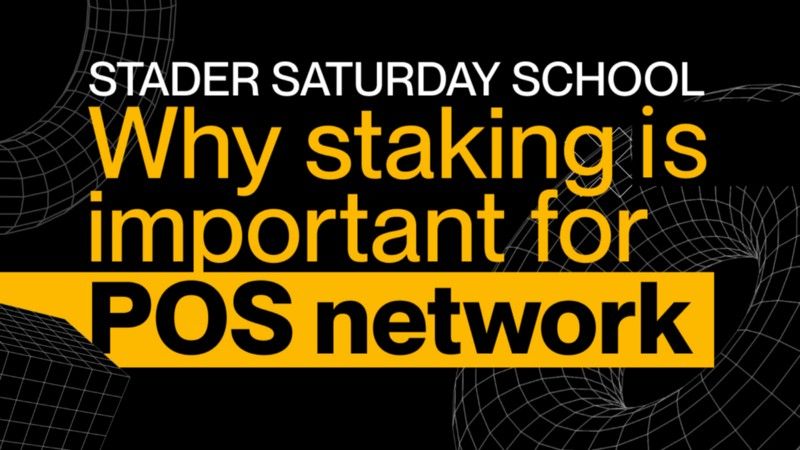Stader Saturday School — Why is staking important for POS networks?
In the current bear market condition & growing inflation rate, people are more inclined towards risk-free assets & for a long-term passive…

In the current bear market condition & growing inflation rate, people are more inclined towards risk-free assets & for a long-term passive income to keep them going. Staking is one such relatively less-risk mechanism where investors get to participate in governing blockchain networks. Not just this, but they will also be rewarded for their contributions.
Apart from earning these juicy incentives and gaining double or triple-digit APY, there is indeed a massive advantage for PoS itself to have staking in its network. As staking offers to be an alternative consensus mechanism to help grow DeFi & other blockchain applications positively.
For the unversed, staking is a process of storing coins or tokens in a cryptocurrency wallet that can be used to validate a transaction on a blockchain network. Most of the time, crypto investors either contemplate mining cryptocurrency or buying it directly on a crypto exchange.
But crypto staking is quite different. Crypto staking, or staking coins/tokens, is another excellent alternative to accumulating assets in one’s crypto wallet.
What do you mean by staking crypto?
Consider staking crypto equivalent to putting money in your bank account. When you deposit some funds in your savings account, the bank takes that money & lends it out to others. In return for depositing those funds with the bank, you are given a percentage of interest you earned from lending your money. In most cases, that portion or percentage is very, very low.
Similarly, when you stake your cryptocurrency or any digital asset, you lock the coins so that you can participate in running the blockchain smoothly while maintaining its security. And in exchange for that, you receive rewards calculated in percentage yields. Yes, these returns are much higher than what the banks offer.
Apart from this, another source of yield can be liquid staking. It is a staking mechanism where crypto holders give their assets to liquidity pools and receive rewards. Often these rewards run up to 100% APYs while you, the liquidity provider, will help PoS networks quickly attract more liquidity.
This way, staking has become a popular way to make profits in crypto without actually trading your coins or tokens in the DeFi world.
How Crypto Staking Works?
It is a fact that crypto staking is a passive activity. When a crypto investor starts to stake their holdings, that leaves them in their crypto wallet. The network then uses those coins/tokens to build new blocks on the blockchain.
The trick here is that the more crypto you stake, the more chances your crypto holdings will be selected and used to forge new blocks.
This way, information is ‘written’ into this new block, and your holdings are used to validate it. As we know, coins also have “baked-in” data from the blockchain, which is used as validators. Here comes the best part! For allowing your crypto holdings to be used as validators, the blockchain network rewards you, the staker!
Advantages of staking crypto
There are various reasons why staking is essential, especially for PoS networks;
- More decentralized as multiple validators will be processing your crypto funds to run the blockchain network.
- Get potentially high returns (basically depending on which crypto you are staking)
- You play a crucial role in running a blockchain ecosystem resistant to attacks [by 51%] & run a PoS network in a smooth secured manner — just by staking your coins/tokens.
- There is no need for any advanced or complex computational equipment like it is needed for crypto mining.
- Earn passive rewards and other juicy yield farming opportunities for your staking.
- Apart from the incentives, you will also get to participate in the “governance” of the blockchain ecosystem through a “governance token.” You will have a say in future network changes or upgrades.
- You have “ownership” throughout the crypto staking process.
But with every benefit unquestionably come some risks.
Risks of staking crypto
Staking your crypto isn’t risk-free. But having said that, you can convert that risks into your strengths with a right & proper DYOR and nil negligence.
- The value of your staked crypto will not remain in a constant state. Prices often fluctuate, so you must know your risk appetite before staking your cryptocurrency.
- Some proof-of-stake cryptocurrencies have lock-up periods. This means you would not be able to access your crypto for a specified period.
- You trust a crypto exchange for staking your crypto, which sometimes might lead to security risks.
But having said that, you can convert that risks into your strengths with the right DYOR and nil negligence. So to stake your crypto, it is good to analyze your risk-to-reward ratio based on the current market conditions and then take a plunge.
Indeed staking is crucial for PoS networks as they run the entire blockchain ecosystem safely, securely, and in a more decentralized manner.